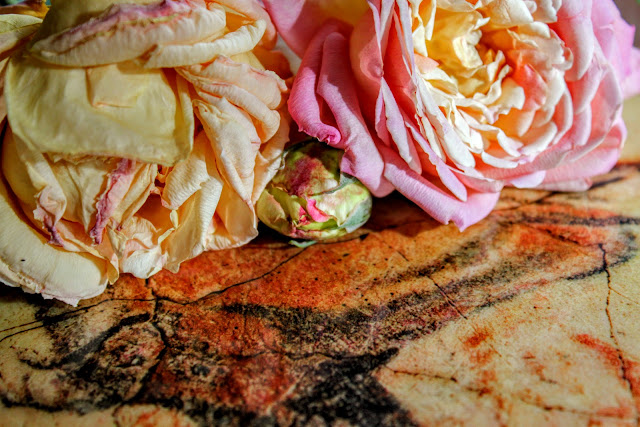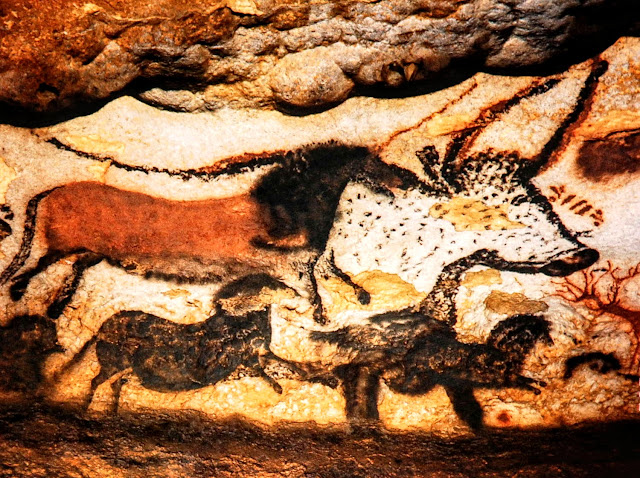Creative expression is primal. Whether you are an artist, or a scientist, creativity is in the DNA of mankind. Cave drawings have been found in Indonesia, Australia, Europe, the USA, and Canada, some dating back as far as 40-thousand years ago.
Every day, as I sit down to a meal, I find myself staring at the ochre and zinc oxide animal images from the Altamira caves in Spain, and the famous Lascaux caves in the Dordogne Region of France. I may not eat a Paleo Diet, however, I do have paleolithic images on my placemats!
The drawings are powerful. They incorporate every bump in the cave walls, giving the bulls, horses and other animals a 3D effect, at once becoming both paintings and sculptures. There's also a strong sense of movement. One of the first people to see Lascaux's Hall of Bulls, described it as a, "cavalcade of animals larger than life painted on the walls and ceiling of the cave; each animal seemed to be moving". One of the bulls stretches 5.18 metres (17 feet) across the cave wall - the largest cave drawing of an animal anywhere in the world.
The Don himself, started exploring and excavating the caves in 1875, and found bones of extinct giant stag, wild horses, and bison. Four years later, he found paleolithic implements. The biggest find, would be made by his young daughter.
Depending on what account you read, Maria was five, six, eight, nine, eleven or twelve years old, when she accompanied her father on one of his archaeological excavations. He was not far away from her, when he heard her call, "toros!" Bulls, barely visible on the cave ceiling. Well, bison actually, said her father. Maria had discovered what would eventually be known as the "Sistine Chapel of Prehistory". Eventually...
French archeologists, were less than impressed. They didn't believe that, "primative people could create such art". The nobleman was accused of fraud. They said an artist, living in the castle, painted the cave drawings himself, and it was an elaborate hoax by one con artist, and his artist. Don Sanz de Sautuda died in 1888, fifteen years before he would be proven honest and right.
Between 1895 and 1901, more art was found in caves in Northern Spain and in France (there are about 340 such caves in the region). In 1902, one of the late nobleman's worst accusers, French archaeologist Emile Cartailhac, published, "Mea Culpa d'un Sceptique", in the journal L'Anthropology. Maria's father was vindicated, and his descendants would go on to become Bankers (with a capital B)!
The caves are breathtaking. With every inhaled gasp, there's an exhale of carbon dioxide. For every muddy shoe that steps into the caves, and every hand that touches the walls, there's bacteria from the outside. The carbon dioxide, humidity, and contaminants have all caused disintegration of the cave drawings in both Altamira and Lascaux. In 1998, fungus, blamed on a newly installed air conditioning system, began appearing in the Lascaux caves, causing black and white stains. In 2008, a black mold appeared.
Lascaux has a protective layer of chalk, which preserved the paintings for millenia, by making the cave waterproof. It took modern man only a few decades to disturb the ecosystem. As Yvan Moenne Loccose, Lascaux's Microbiologist says, the "cave has its own microbiota, whose balance has only recently been disrupted by man".
Little can be done about the bacteria, fungus and mold. They tried fungicides, antibiotics, and chemicals. New micro-organisms would appear. Right now, they're only scratching the surface. Yes, actually, scratching the walls with a monthly mechanical and chemical treatment. Time is not on the side of this World Heritage Site.
The young scientists used their collective genius, and creative ideas to find a possible solution, using synthetic biology to restrain the damage. They sought input from other scientists, and the people who live in the region. They created a bacterium that would kill bacteria, and linked it to a toxin/anti-toxin system, that will kill the bacterium if it mutates. To prevent the new bacterium from leaving the cave, they implanted a biological switch inside the bacterium, that would kill the bacterium once it detected too much light. Think: vampire bacteria!
Despite being closed for years, tourists are still trekking to the caves of Altamira and Lascaux. In France, there's an exact replica of the Lascaux Caves, built in 1983. It only has two of the halls, however, they're the most famous ones. Ironically, after the cries of "fake", that greeted the news of the Altamira discovery, a complete replica of the Spanish site was built in 2001. It is tourist friendly, with good lighting, hand rails, and a smooth, even floor. Unfortunately, no one is allowed to take pictures - with or without a flash. You have to buy the book.
More caves are being discovered all the time...in June 2016, 70 paleolithic cave paintings were discovered in Basque country. The 14-thousand year old Atxurra caves are said to be, "pristine".
More caves are being discovered all the time...in June 2016, 70 paleolithic cave paintings were discovered in Basque country. The 14-thousand year old Atxurra caves are said to be, "pristine".
...and yes, those are the last of the Chicago Peace tea roses which grew on my balcony all Summer and Fall.
Altamira and Lascaux images from Wiki Images.
Photographs Copyright of: Ruth Adams, Widow's Endorphins Photographic Images Incorporated.








No comments:
Post a Comment